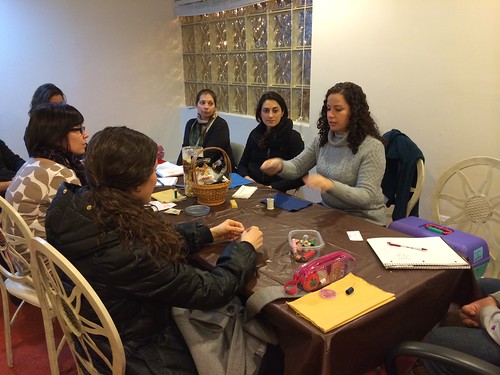Class Report
Make It Work! Mending and Fixing Clothes

Teacher: Jules Rincon, writer, sewer, knitter (at right, in gray sweater)
Documentarian: Sami Simon
Location: SCRAP DC
Class Date: Jan. 8, 2014
What was the most surprising thing you learned in class?
Sami: How many bad things can befall clothing. Students brought in misaligned zippers, split pants, and fallen hems for guidance on how to best fix them.
What did you learn that you can put into practice immediately?
Sami: How to sew a button properly. I have so many sweaters, jackets, and shirts with missing or misaligned buttons that I can now save with my new skills.
How did you get interested in mending?
Jules: I grew up seeing my mother wield needle and thread. In her crafty hands, pockets would be fixed, buttons refastened, seams rejoined, and clothing re-purposed, ready to live a second or third lifetime. If something broke, we fixed it. She taught me how to use a sewing machine and sew by hand, and through her I learned I could make with my hands the things that existed in my head.
What do people tend to wrongly assume about mending before learning about it?
Jules: People tend to think it’s more complicated than it is, or that they don’t have time for it. It may actually take longer to take an item to a tailor (or buy a new one) than to fix it yourself.
Some people feel that wearing mended clothing telegraphs to others that you can’t afford to buy something new. While I don’t agree with this sentiment, I understand that it could be hard to shake off the feeling, especially when mending is not by choice but necessity. There are many ways to make repairs practically invisible, or when they are in a visible area, to make them features instead of blemishes, so that the mended article looks fashionable or trendy.
What can people read/watch for more information mending?
Jules: The public libraries in D.C. have quite a few books on the basics of sewing. The Internet is my reference tool of choice. I do general web searches when I have questions on a specific technique or want to confirm that my approach to a repair makes sense. I use Pinterest to gather interesting links to sewing and other crafty projects and, when I need to learn a new skill, YouTube helps me see how different people do it. “Refashioning,” “diy,” “upcycling,” and “sewing tutorials” are good phrases to look up for a start.
Any groups in the area devoted to mending/fixing clothes?
Jules: I run a Crafty Meetup (see SCRAP’s schedule here) the first and third Tuesdays of every month at 6:30 p.m. at SCRAP DC, and I encourage people to bring their mending! My friend Sherry and I are also starting a mending pop-up project where we plan to drop in at different locations around the city to teach mending. I’ll also be teaching sewing classes, both for groups and individuals, at SCRAP.
If an alien visited Earth and could understand English, what would she/he/it assume about humanity from your class?
Jules: That humans — seemingly soft and spongy — have secret sharp edges that destroy clothing from the inside.
See more photos from this class on Flickr!
